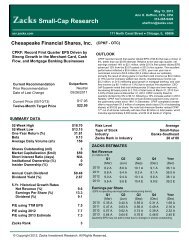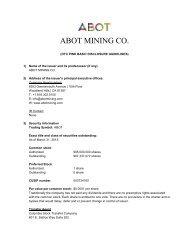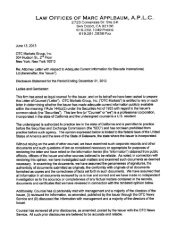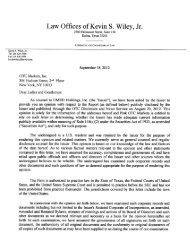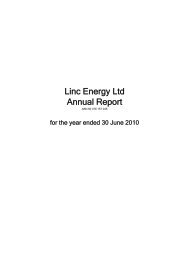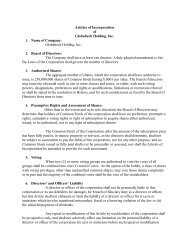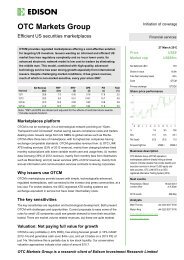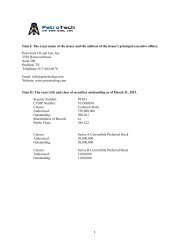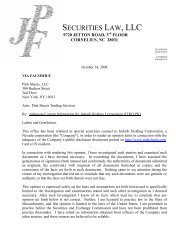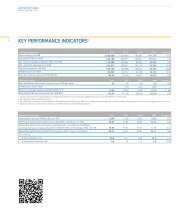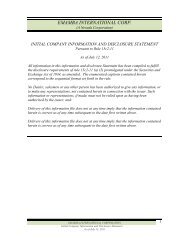2011 Annual Report - OTCIQ.com
2011 Annual Report - OTCIQ.com
2011 Annual Report - OTCIQ.com
You also want an ePaper? Increase the reach of your titles
YUMPU automatically turns print PDFs into web optimized ePapers that Google loves.
52 Risk <strong>Report</strong><br />
Commodity Price Risks<br />
The E.ON Group’s business operations are exposed to <strong>com</strong>modity<br />
price risks. In order to limit our exposure to these risks,<br />
we conduct systematic risk management. The key elements<br />
of our risk management are, in addition to binding Group-wide<br />
guidelines and a Group-wide reporting system, the use of<br />
quantitative key figures, the limitation of risks, and the strict<br />
separation of functions between departments. To limit <strong>com</strong>modity<br />
price risks, we utilize derivative financial instruments<br />
that are <strong>com</strong>monly used in the marketplace. These instruments<br />
are transacted with financial institutions, brokers, power<br />
exchanges, and third parties whose creditworthiness we<br />
monitor on an ongoing basis. The Trading unit aggregates and<br />
consistently manages the price risks we face on Europe’s liquid<br />
<strong>com</strong>modity markets.<br />
We mainly use electricity, gas, coal, carbon allowance, and oil<br />
price hedging transactions to limit our exposure to risks<br />
resulting from price fluctuations, to optimize systems and load<br />
balancing, and to lock in margins. We also engage in proprietary<br />
<strong>com</strong>modity trading in accordance with detailed guidelines<br />
and within narrowly defined limits.<br />
Financial Risks<br />
The international nature of E.ON’s business operations exposes<br />
E.ON to risks from currency fluctuation. One form of this risk<br />
is transaction risk, which occurs when payments are made in<br />
a currency other than E.ON’s functional currency. Another form<br />
of risk is translation risk, which occurs when currency fluctuations<br />
lead to accounting effects when assets/liabilities and<br />
in<strong>com</strong>e/expenses of E.ON <strong>com</strong>panies outside the euro zone are<br />
translated into euros and entered into our Consolidated Financial<br />
Statements. We limit currency risk by conducting systematic<br />
currency management involving derivative and underlying<br />
financial instruments. Currency-translation risk results mainly<br />
from transactions denominated in U.S. dollars, pounds sterling,<br />
Swedish kroner, Norwegian kroner, and Hungarian forints.<br />
E.ON faces earnings risks from financial liabilities, accounts<br />
payable, short-term financing with variable interest rates, and<br />
interest derivatives that are based on variable interest rates.<br />
We also use systematic risk management to manage our<br />
interest-rate and currency risks. Here, E.ON AG plays a central<br />
role by aggregating risk positions through intragroup transactions<br />
and hedging these risks on the market. Due to its intermediary<br />
role, E.ON AG’s risk position is largely closed.<br />
E.ON’s operating activities and use of derivative financial instruments<br />
expose E.ON to credit-default risks. We use a Groupwide<br />
credit risk management system to systematically monitor<br />
the creditworthiness of our business partners on the<br />
basis of Group-wide minimum standards. We manage our creditdefault<br />
risk by taking appropriate measures, which include<br />
obtaining collateral and setting limits. The E.ON Group’s Risk<br />
Committee is regularly informed about all material creditdefault<br />
risks.<br />
E.ON could face liquidity risks due to margin calls resulting<br />
from adverse price developments of derivative financial<br />
instruments.<br />
In addition, E.ON also faces risks from price changes and<br />
losses on the current and non-current investments it makes<br />
to cover its non-current obligations, particularly pension and<br />
asset-retirement obligations. The foundation of our risk management<br />
in this area is a conservative investment strategy<br />
and a broadly diversified portfolio.



